
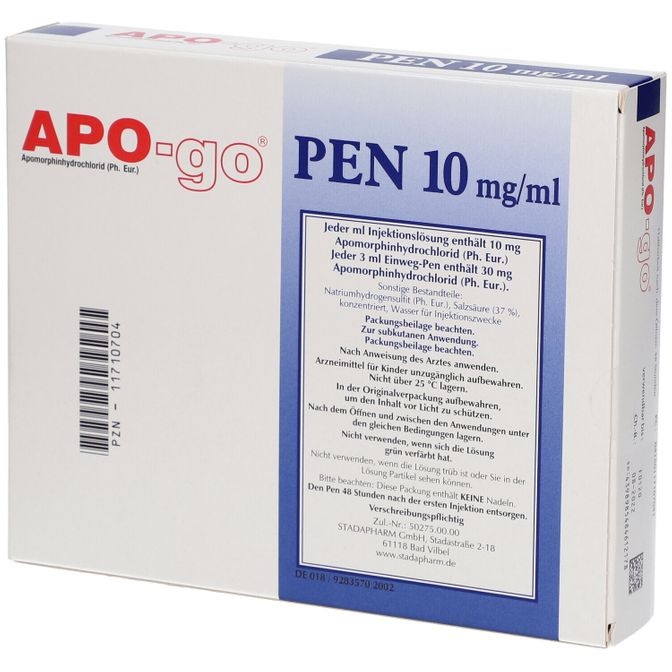
APO-GO PEN 10 mg/ml INJECTABLE SOLUTION

Ask a doctor about a prescription for APO-GO PEN 10 mg/ml INJECTABLE SOLUTION

How to use APO-GO PEN 10 mg/ml INJECTABLE SOLUTION
Introduction
Package Leaflet: Information for the User
APO-go PEN 10 mg/ml solution for injectionApomorphine hydrochloride
(* Referred to as APO-go in the text)
For use in adults
Read all of this leaflet carefully before you start using this medicine, because it contains important information for you.
- Keep this leaflet, you may need to read it again.
- If you have any further questions, ask your doctor, nurse or pharmacist.
- This medicine has been prescribed for you, do not pass it on to others, even if their symptoms are the same as yours, as it may harm them.
- If you experience any side effects, talk to your doctor or pharmacist, even if they are not listed in this leaflet. See section 4.
Contents of the pack:
- What APO-go Pen is and what it is used for.
- What you need to know before you start using APO-go Pen.
- How to use APO-go Pen.
- Possible side effects.
- Storing APO-go Pen.
- Contents of the pack and further information.
1. What APO-go Pen is and what it is used for
APO-go Pen contains a solution for injection of apomorphine which is injected under the skin (subcutaneously). The active substance in APO-go Pen is apomorphine hydrochloride. Each milliliter of solution contains 10 mg of apomorphine.
Apomorphine hydrochloride is a medicine belonging to the group known as dopaminergic agonists. APO-go Pen is used to treat Parkinson's disease. Apomorphine helps to reduce the time spent in the "off" state or immobile state in patients who have been previously treated with levodopa and/or other dopaminergic agonists for Parkinson's disease. Your doctor or nurse will help you recognize the signs that indicate when you should use this medicine.
Despite the name of the medicine, apomorphine does not contain morphine.
2. What you need to know before you start using APO-go Pen
Before using APO-go Pen, your doctor will perform an ECG (electrocardiogram), and will ask you for a list of all other medicines you are taking. This ECG will be repeated in the first few days of treatment, and at any time your doctor considers it necessary. Your doctor will also ask you about other diseases you may have, especially those related to the heart. Some of the questions and additional tests may be repeated at each medical visit. If you have symptoms that may be related to your heart, such as palpitations, fainting or dizziness, you should inform your doctor immediately. If you have diarrhea or start using a new medicine, you should also inform your doctor.
Do not use APO-go Pen if:
- you are under 18 years old
- you have breathing difficulties
- you have dementia or Alzheimer's disease
- you have any mental illness with symptoms such as hallucinations, delusions, confusion or loss of contact with reality
- you have liver problems
- you have severe dyskinesia (involuntary movements) or severe dystonia (inability to move) despite taking levodopa
- you are allergic to apomorphine or any of the other components of this medicine (listed in section 6)
- you or a family member have an alteration in your electrocardiogram (ECG) known as "long QT interval syndrome"
- you are taking ondansetron (a medicine used to treat nausea and vomiting)
Warnings and precautions
Consult your doctor, pharmacist or nurse before starting to use APO-go Pen if:
- you have kidney problems
- you have lung problems
- you have heart problems
- you have low blood pressure or feel weak or dizzy when standing up
- you are taking another medicine to treat high blood pressure
- you have nausea or vomiting
- your Parkinson's disease causes certain mental problems such as hallucinations and confusion
- you are elderly or frail
Tell your doctor if you or your family members/caregivers notice that you are developing impulses or cravings to behave in an unusual way for you and cannot resist the impulse, drive or temptation to carry out certain activities that may be harmful to you or others. These behaviors are called impulse control disorders and may include addictive gambling, overeating or excessive spending, an abnormally high sex drive or an increase in sexual thoughts or feelings. Your doctor may need to adjust or interrupt your dose.
Some patients develop symptoms of addiction that lead to a compulsive desire to consume high doses of APO-go Pen and other medicines used in the treatment of Parkinson's disease.
If you experience any of the situations described, please inform your doctor or nurse.
Children and adolescents
APO-go Pen should not be used in children and adolescents under 18 years old.
Using APO-go Pen with other medicines
Tell your doctor or pharmacist if you are taking, have recently taken or might take any other medicines.
Consult your doctor or pharmacist before taking this medicineif:
- you are using medicines that affect how your heart beats. This includes medicines used to treat heart rhythm problems (such as quinidine and amiodarone), for depression (such as tricyclic antidepressants like amitriptyline and imipramine) and for bacterial infections (macrolide antibiotics such as erythromycin, azithromycin and clarithromycin) and domperidone
- you are taking ondansetron (a medicine used to treat nausea and vomiting) as this may cause you to have severe low blood pressure and loss of consciousness
If you use this medicine at the same time as other medicines, the effect of these medicines may be altered. This is especially true for:
- medicines such as clozapine for treating mental disorders
- medicines for lowering high blood pressure
- other medicines used to treat Parkinson's disease
Your doctor will inform you if you need to change the dose of apomorphine or any other medicine you are using.
If you are using levodopa (another medicine for Parkinson's disease) in addition to APO-go Pen, your doctor should perform regular blood tests.
Using APO-go Pen with food and drinks
Food and drinks do not affect how this medicine works.
Pregnancy and breastfeeding
APO-go Pen should not be used during pregnancy unless clearly necessary.
If you are pregnant or breastfeeding, think you may be pregnant or are planning to have a baby, ask your doctor or pharmacist for advice before using this medicine.
It is not known if APO-go Pen is excreted in breast milk. Ask your doctor if you are breastfeeding or think you may be breastfeeding. Your doctor will explain if you should continue or stop breastfeeding, and if you should continue taking this medicine or stop it.
Ask your doctor or pharmacist for advice before taking any medicine.
Driving and using machines
APO-go Pen may cause drowsiness and a strong desire to sleep. You should not drive or use machines if this medicine has this effect on you.
APO-go Pen contains sodium metabisulfite:APO-go Pen contains sodium metabisulfite (E-222), which, in rare cases, can cause severe allergic reactions with symptoms such as rash or itching of the skin, difficulty breathing, swelling of the eyelids, face or lips, inflammation or redness of the tongue. If you experience these side effects, go to the nearest hospital immediately.
APO-go Pen contains less than 23 mg (1 mmol) of sodium per 10 ml, so it is considered essentially "sodium-free"
3. How to use APO-go Pen
Before using APO-go Pen, your doctor will check that you tolerate this medicine and an antiemetic medicine that you must take at the same time.
Follow exactly the administration instructions of this medicine indicated by your doctor or pharmacist. In case of doubt, consult your doctor or pharmacist again.
You must take domperidone, at least 2 days before using APO-go Pen to avoid nausea or vomiting.
Do not use APO-go Pen if:
- the solution has turned green
- the solution is cloudy or you notice the presence of particles
Where to inject APO-go Pen
- inject APO-go Pen into a subcutaneous area according to your doctor's or nurse's instructions
- do not inject APO-go Pen into a vein
How much to use
The amount of APO-go Pen you should use and how often will depend on your personal needs. Your doctor will discuss this with you and recommend the amount of medicine you should use. The suitable dose for you will be determined during your visit to the specialist.
- The normal daily dose is between 3 mg and 30 mg
- You may need up to 100 mg per day
- Normally you will need between 1 and 10 injections per day
- Each injection should not have a dose greater than 10 mg
Before using APO-go Pen, study the following diagram and your pen to familiarize yourself with your medicine.
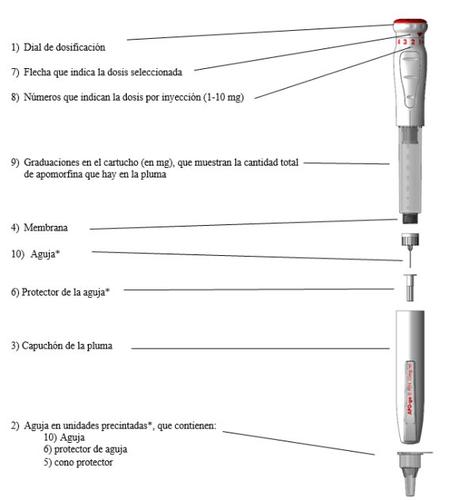
- The pack does not contain needles for use with your pen. Use pen needles no longer than 12.7 mm and with a gauge no smaller than 0.31 mm (30G)
The pen needles recommended for use with insulin pens are compatible with APO-go Pen.
IMPORTANT: do not pull the red dosing dial (see 1) before you have selected the dose (see "how to select your correct dose")
Attaching the needle
(a) Before using APO-go Pen you will need sterile swabs and a needle with its protective cone (see 2).
(b) Take the pen out of its pack and remove the cap (see 3).

(c) Clean the pen membrane (see 4) with a sterile swab.

(d) Remove the paper from the protective cone (see 2).


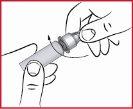

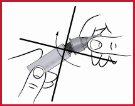
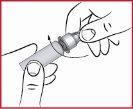
(e) It is important to put the needle in a straight line with the pen, as shown in the previous drawing. If the needle is at an angle, it may cause the pen to leak.
(f) Screw the cone (see 2) onto the pen membrane in a clockwise direction until it is tight. This secures the needle in place.
(g) Remove the protective cone (see 5), but do not throw it away. Do not remove the needle protector (see 6) yet.

(h) Put the pen cap back on (see 3).
How to select the correct dose
(i) Press the red dosing dial (see 1) and turn it clockwise while keeping it pressed until the arrow points to the dose prescribed by your doctor (see 7, 8); then release the pressure on the red dosing dial. The dose is now selected and you will not need to manipulate the dial for subsequent injections.

Important:if you have exceeded the prescribed dose while turning the dial, you must continue pressing and turning in the same direction until it points to the prescribed dose again. Never pull and turn the red dosing dial at the same time
If your dose is 1 mg, start by expelling a 1 mg dose onto a paper tissue and then discard the tissue. This is called "priming" the pen and it is important because it ensures that the correct dose is administered the first time the pen is used. After priming, select the required dose and inject the Pen in the usual way (see "How to perform the injection"). If the first dose is greater than 1 mg, then you do not need to "prime" the pen.
How to perform the injection
(j) Once you have selected your dose, carefully pull the red dosing dial out to its stop. Check the red scale on the plunger (see 9) and only inject if the visible line corresponds to the desired dose.
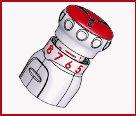
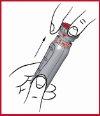
(k) Clean the skin area where you will inject with a sterile swab.
(l) Remove the pen cap (see 3).
(m) Remove the needle protector (see 6).

(n) Insert the needle (see 10) into the skin, according to your doctor's instructions.
(o) To inject the dose, press the red dosing dial (see 1) down as far as it will go, using your thumb if possible. Once the red dosing dial is fully pressed, count to three before removing the needle.
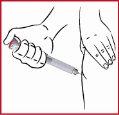
(p) Put the protective cone (see 5) over the used needle by pushing it gently until it is in place. Once secure, turn the needle counterclockwise to unscrew it. Keep the needle inside the protective cone and dispose of it safely in a needle container or an empty coffee jar.
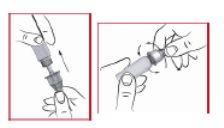
How to prepare the next injection
(q) Remove the pen cap and check that there is enough apomorphine left in the cartridge to perform the next injection. If there is, put a new needle in place in the same way as before.
(r) If there is not enough apomorphine left for another injection, prepare another pen.
(s) Finally, put the pen cap back on.

If you use more APO-go Pen than you should
In case of overdose or accidental ingestion, consult your doctor or call the Toxicology Information Service, phone 91 562 04 20, indicating the medicine and the amount taken.
- Tell your doctor or contact the emergency department of the nearest hospital immediately
- You may notice that your heart beats more slowly, nausea or vomiting, excessive drowsiness and/or difficulty breathing. You may also feel weak or dizzy, especially when standing up due to low blood pressure. Lying down with your feet raised will help you feel better
If you forget to use APO-go Pen
If you forget a dose, wait for the next one. Do not use a double dose to make up for the forgotten dose
If you stop using APO-go Pen
Do not stop using APO-go Pen without consulting your doctor first
If you have any further questions about the use of this medicine, ask your doctor, pharmacist or nurse
4. Possible Adverse Effects
Like all medicines, this medicine can cause adverse effects, although not all people suffer from them.
If you experience an allergic reaction, stoptreatment with APO-go Pen and contact your doctor or the emergency service of the nearest hospital immediately. The symptoms of an allergic reaction may be:
- rash
- difficulty breathing
- swelling of the face, lips, throat, or tongue.
APO-go Pen may cause, sometimes, the following adverse effects:
Very common (may affect more than 1 in 10 people):
- appearance of lumps under the skin at the injection site that are painful, annoying, and may become red and cause itching. To avoid the appearance of these lumps, it is recommended to change the injection site each time the needle is inserted
- hallucinations (seeing, hearing, or feeling things that do not exist).
Common (may affect up to 1 in 10 people):
- nausea and vomiting, especially when starting treatment with APO-go Pen. If you are taking domperidone and still feel nausea or have vomiting, or if you are not taking domperidone and feel nausea or have vomiting, consult your doctor as soon as possible.
- fatigue or excessive drowsiness.
- confusion or hallucinations.
- yawning.
- feeling dizzy or weak when standing up.
Uncommon (may affect up to 1 in 100 people):
- Increased involuntary movements or increased tremors during "on" periods.
- Hemolytic anemia (abnormal destruction of red blood cells in blood vessels or other parts of the body). This is an uncommon adverse effect that may occur in patients who also take levodopa.
- Sudden sleepiness.
- Rash.
- Difficulty breathing.
- Ulceration of the injection site.
- Reduction in the number of red blood cells, which can lead to pale skin and cause weakness and shortness of breath.
- Reduction in the number of platelets, which increases the risk of bleeding or hematoma.
Rare (may affect up to 1 in 1000 patients):
- Allergic reaction.
- Eosinophilia (abnormally high amount of white blood cells in the blood or tissues of the body).
Frequency not known: cannot be estimated from available data:
- Swelling of legs, feet, or toes.
- Inability to resist the impulse, desire, or temptation to perform an action that could be harmful to you or others, which may include:
- Strong impulse to gamble excessively, despite serious personal or family consequences.
- Alteration or increase in sexual interest and behavior in a significant way with oneself or with others, for example, increased sexual impulse.
- Uncontrollable spending or excessive shopping
- Binge eating (eating large amounts of food in a short period) or compulsive eating (eating more food than normal and more than necessary to satisfy hunger).
- Fainting.
- Aggression, agitation.
- Headache.
Tell your doctor if you experience any of these behaviors; your doctor will indicate how to control or reduce the symptoms.
Reporting of Adverse Effects
If you experience any type of adverse effect, consult your doctor or pharmacist, even if it is a possible adverse effect that does not appear in this prospectus. You can also report them directly through the Spanish Pharmacovigilance System for Human Use Medicines: https://www.notificaRAM.es. By reporting adverse effects, you can contribute to providing more information on the safety of this medicine.
5. Conservation of APO-go PEN
Keep this medicine out of sight and reach of children.
Do not use this medicine after the expiration date that appears on the label and on the box. The expiration date is the last day of the month indicated.
Do not store at a temperature above 25°C. Keep the cartridge in the cardboard case to protect it from light.
Store in the same storage conditions after opening and between successive uses.
Do not use this medicine if the solution has turned green. It should only be used if the solution is clear, colorless, and without visible particles.
When you start using a new package of APO-go Pen, it can be used for up to 48 hours. Do not reuse it after this time. Use a new pen.
To safely dispose of your pens, always remove the needle from the pen before disposing of it, for example, in a needle container or an empty coffee jar.
When the needle container is full, give it to your doctor or pharmacist for safe destruction. If the pen is completely empty, you can throw it away with household waste.
Medicines should not be thrown down the drain or into the trash. Deposit the packages and medicines you no longer need at the SIGRE point in the pharmacy. In case of doubt, ask your pharmacist how to dispose of the packages and medicines you no longer need. This way, you will help protect the environment.
6. ADDITIONAL INFORMATION
Composition of APO-go PEN
- The active ingredient is apomorphine hydrochloride. Each milliliter of APO-go PEN contains 10 mg of apomorphine hydrochloride. Each APO-go PEN contains 3 ml of injectable solution.
- The other components (excipients) are:
- sodium metabisulfite (E223)
- hydrochloric acid (37%)
- water for injection.
See section 2: APO-go PEN contains sodium sulfite.
Appearance of the Product and Package Contents
APO-go PEN 10 mg/ml is a disposable pen-type injection system, multiple doses, which incorporates a transparent glass cartridge containing the apomorphine injectable solution. The solution is clear, practically colorless, odorless, and without visible particles.
The packages contain 1, 5, or 10 pens in a molded plastic tray in a cardboard case.
APO-go Pen is available in packages of 1, 5, or 10 pens and in multiple packages containing 5 cases with 5 pens each.
Only some package sizes may be marketed.
Marketing Authorization Holder
STADA Arzneimittel AG
Stadastraße 2-18
61118 Bad Vilbel, Germany
Manufacturer
Laboratoire Aguettant
1 Rue Alexander Fleming
Boite Postale 7144
69353 Lyon, Cedex 07 – France
or
STADA Arzneimittel AG
Stadastr. 2 – 18
61118 Bad Vilbel
Germany
You can request more information about this medicine by contacting the local representative of the marketing authorization holder:
ITALFARMACO S.A.
San Rafael, 3
28108 Alcobendas (Madrid)
Spain
This medicine is authorized in the Member States of the European Economic Area and in the United Kingdom (Northern Ireland) with the following names:
Austria, Germany: APO-go PEN 10 mg/ml Injektionslösung
Belgium: APO-GO®-PEN 10 mg/ml oplossing voor injectie
Bulgaria: A?O-?o® ??????? 10mg/ml ??????????? ???????
Cyprus: APO-go Συσκευ? τ?που π?νας 10 mg/ml Εν?σιμο Δι?λυμα
Czech Republic: Britaject PEN
Denmark: APO-go PEN 10mg/ml Injektionsv?ske, opl?sning
Estonia: APO-go, 10 mg/ml süstelahus pen-süstlis
Finland: Apogo PEN 10 mg/ml injektioneste, liuos
Greece: APO-go Συσκευ? τ?που π?νας10 mg/ml Εν?σιμο Δι?λυμα
Ireland, Malta, United Kingdom: APO-go Pen 10mg/ml solution for injection
Latvia: APO-go PEN 10 mg/ml škidums injekcijam
Lithuania: Britaject 10 mg/ml injekcinis tirpalas
Luxembourg: APO-go® PEN 10mg/ml Solution Injectable
Netherlands: APO-go PEN, Oplossing Voor injectie 10mg/ml
Norway: Britaject 10 mg/ml injeksjonsvæske, oppløsning i ferdigfylt penn
Portugal: Apo-go Pen 10 mg/ml Solução injectável
Romania: APO-go 10 mg/ml solutie injectabila în pen multidoza
Slovenia: APO-go 10 mg/ml raztopina za injiciranje v peresniku
Spain: APO-go PEN 10 mg/ml Solución inyectable
Sweden: APO-go PEN 10 mg/ml Injektionsvätska, lösning
Date of the last revision of this prospectus:March 2025
Detailed and updated information on this medicine is available on the website of the Spanish Agency for Medicines and Health Products (AEMPS) http://www.aemps.gob.es
- Country of registration
- Active substance
- Prescription requiredYes
- Manufacturer
- This information is for reference only and does not constitute medical advice. Always consult a licensed doctor before taking any medication. Oladoctor is not responsible for medical decisions based on this content.
- Alternatives to APO-GO PEN 10 mg/ml INJECTABLE SOLUTIONDosage form: INJECTABLE, 10 mg/mLActive substance: apomorphineManufacturer: Stada Arzneimittel AgPrescription requiredDosage form: INJECTABLE PERFUSION, 5 mg/mLActive substance: apomorphineManufacturer: Stada Arzneimittel AgPrescription requiredDosage form: INJECTABLE, 5 mg/mlActive substance: apomorphineManufacturer: Stada Arzneimittel AgPrescription required
Alternatives to APO-GO PEN 10 mg/ml INJECTABLE SOLUTION in other countries
The best alternatives with the same active ingredient and therapeutic effect.
Alternative to APO-GO PEN 10 mg/ml INJECTABLE SOLUTION in Poland
Alternative to APO-GO PEN 10 mg/ml INJECTABLE SOLUTION in Ukraine
Online doctors for APO-GO PEN 10 mg/ml INJECTABLE SOLUTION
Discuss dosage, side effects, interactions, contraindications, and prescription renewal for APO-GO PEN 10 mg/ml INJECTABLE SOLUTION – subject to medical assessment and local rules.







